Role of Voglibose in the Treatment of Prediabetes in Indian Population: A Cross-Speciality Survey
Pavitra Raj Dewda1, Sourabh Agrawal2
1 Resident, Department of Pharmacology, Pd. Dr. D. Y. Patil Medical College, Pune, Maharashtra, India.
2 SBU Head, Department of Pharmacology, Shri G S Institute of Techonology & Science, Indore. Madhya Pradesh, India.
NAME, ADDRESS, E-MAIL ID OF THE CORRESPONDING AUTHOR: Dr. Pavitra Raj Dewda, Achal A wing, Prem Nagar, Opp. Surya Shopping Centre, Mira Road East, Thane, Mumbai, India.
Phone: 9930991265,
E-mail: drpavitra1@gmail.com
Background: Prediabetes is a precursor of overt Type 2 Diabetes Mellitus (DM) and it is associated with insulin resistance and an increased risk for cardiovascular disease. ACE and AACE recommend only lifestyle modifications for the management of prediabetes. A recently published meta-analysis suggested that drug therapy was associated with a better control of diabetes. Voglibose was recently approved for the management of prediabetes in Japan.
Material and Methods:A well-structured questionnaire was sent to 117 doctors across India (52 diabetes specialists, 45 general practitioners, and 20 specialists from other branches of medicine) to understand their views on the management of prediabetes, especially with regards to voglibose.
Results and Conclusion:There was an equivocal response to the question as to whether only diet and exercise were sufficient for the management of prediabetes. Most of the respondents used metformin for the management of prediabetes, while voglibose was the most favoured divond-line drug. Almost all the respondents agreed that the approval which voglibose got in Japan for the management of prediabetes was relevant in India as well. Only 51.3% of all respondents had prescribed voglibose for prediabetes. Thus, voglibose appears to be popular divond-line drug for the management of prediabetes.
Prediabetes,Hypoglycaemia,Metformin,Voglibose
Introduction
Prediabetes is the state in which some, but not all the diagnostic criteria for diabetes are met. It is the ‘grey area’ between normal blood sugar and diabetic levels. Impaired glucose tolerance (IGT), impaired fasting glucose (IFG), and elevated haemoglobin A1c (HbA1c) are intermediate stages which precede prediabetes and all are precursors to overt type 2 DM. Prediabetes is associated with insulin resistance and an increased risk for cardiovascular disease [1].
ADA defines IFG as FBG levels of 100 to 125 mg/dL (5.6 and 6.9 mmol/L), and IGT as two-hour glucose levels of 140 to 199 mg/dL (7.8 to 11.0 mmol/L) on the 75-g oral glucose tolerance test.
Prediabetes has no signs or symptoms. Since most of the cases of prediabetes ultimately progress to diabetes, it is appropriate that these patients who are at risk be identified and managed appropriately, so as to prevent the development of DM.
Whereas many drugs are available and recommended for the management of DM, the ACE and AACE guidelines [2] and ADA [3] only recommend lifestyle modifications for prediabetes. On the other hand, a recently published meta-analysis concluded that the therapy of prediabetic patients with thiazolidinediones and β-glucosidase inhibitors was associated with increased odds of regression to normoglycaemia than with controls [4].
In this regards, we conducted a survey amongst diabetologists, general practitioners and other specialists regarding their perceptions of the usage of various oral Hypoglycaemic Agents (OHAs), especially the β-glucosidase inhibitor, voglibose, in the management of prediabetes.
Material and Methods
A total of 117 health care professionals were included in the study. Among them, 52 were diabetes specialists, 45 were general practitioners, and the remaining 20 were specialists from other branches. All the participants filled and returned a questionnaire which contained 17 questions which concerned about their views and perceptions regarding the management of prediabetes. This study was approved by Ranbaxy Medical Services. All respondents participated in the study by their own will, and no financial incentives or gifts were provided to the respondents for their participation.
RESULTS
While the prevalence of pre-diabetics ranged between 10%-20% across the respondents, almost 85% of the respondents routinely screened their patients for prediabetes. It was almost universally opined that the concept of prevention of diabetes did not hold good.
There was an equivocal response to the question as to whether pre-diabetes be managed with diet and exercise alone, to which 50.4% of all respondents agreed [Table/Fig-1].
Should pre-diabetes be managed with diet and exercise alone?
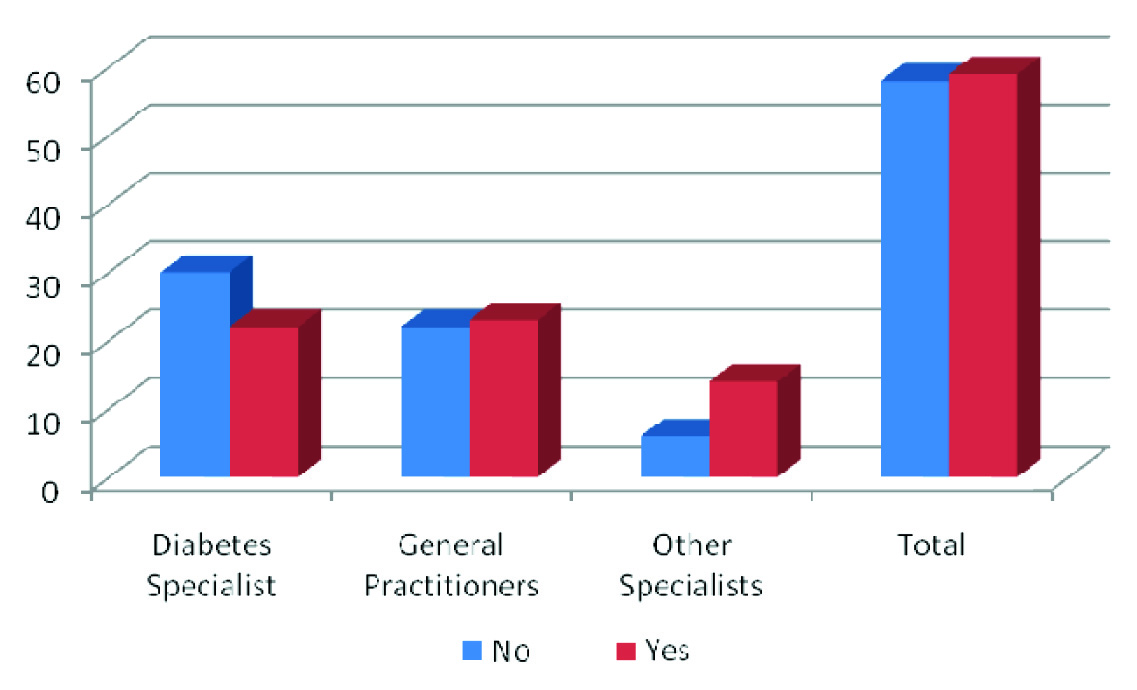
75% of all diabetologists, and 70.7% of respondents from all the categories were of the opinion that prediabetes should be managed with OHAs.
Amongst various classes of drugs which were used for the management of prediabetes, the most often used drug class was biguanides (64.7%), followed by thiazolidinediones (16.2%) and alpha glucosidase inhibitors (14.5%); none of the respondents used DPP IV inhibitors [Table/Fig-2].
Drug usage for the management of prediabetes
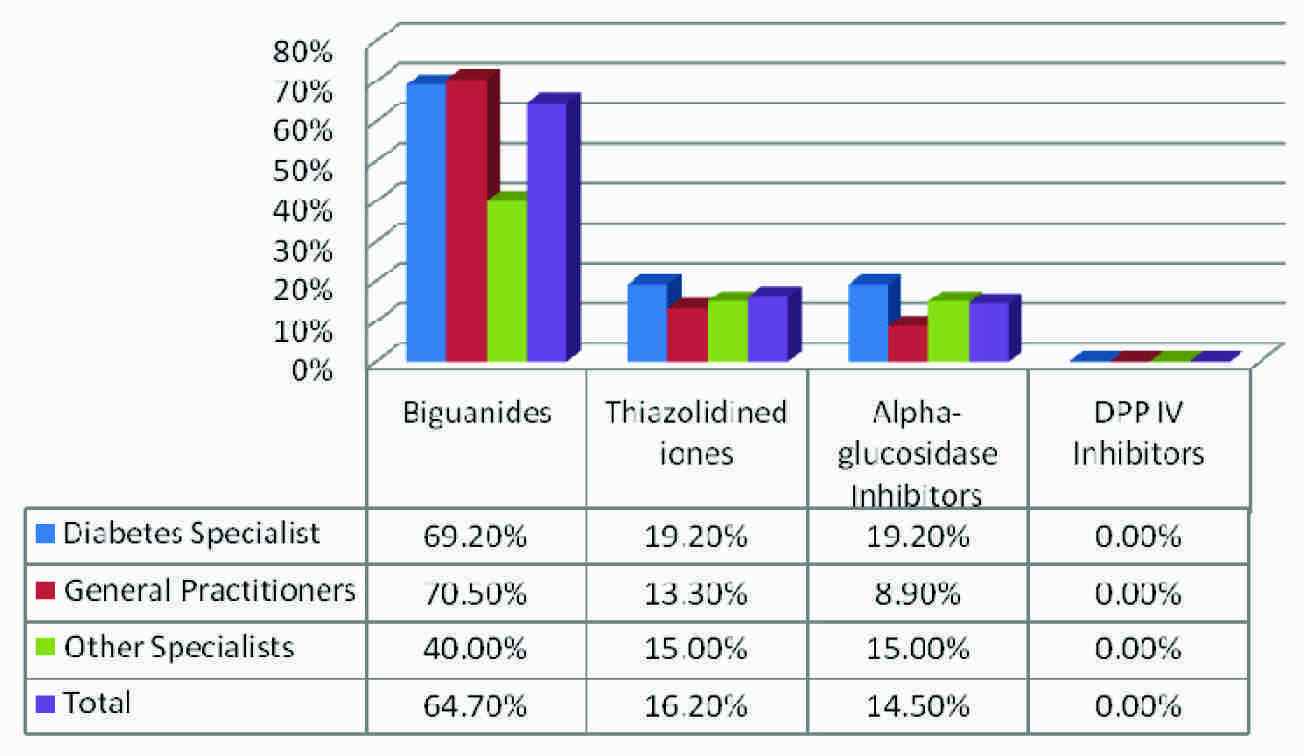
However, when they were asked regarding the order of choice of drug classes for the management of prediabetes, most of them chosen first line was metformin (81%), second line was alpha-glucosidase inhibitors (56.7%), third line was pioglitazone (43.4%), and fourth line was DPP IV inhibitors (55.7%) [Table/Fig-3].
Line of management for prediabetes
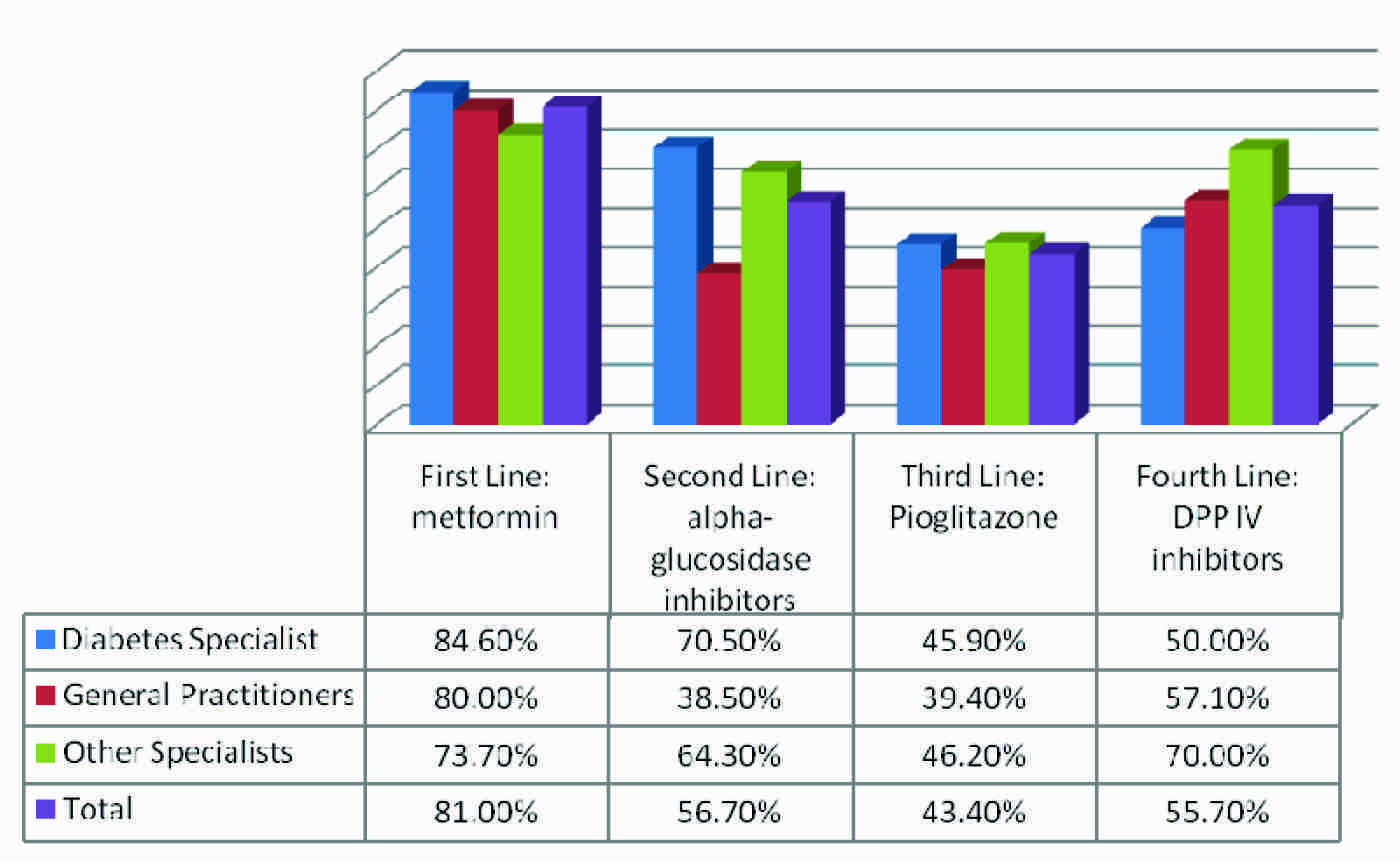
The concern that hypoglycaemia could complicate the drug therapy of prediabetes was shared by most of the respondents [Table/Fig-4].
Is hypoglycaemia a concern in the management of prediabetes?
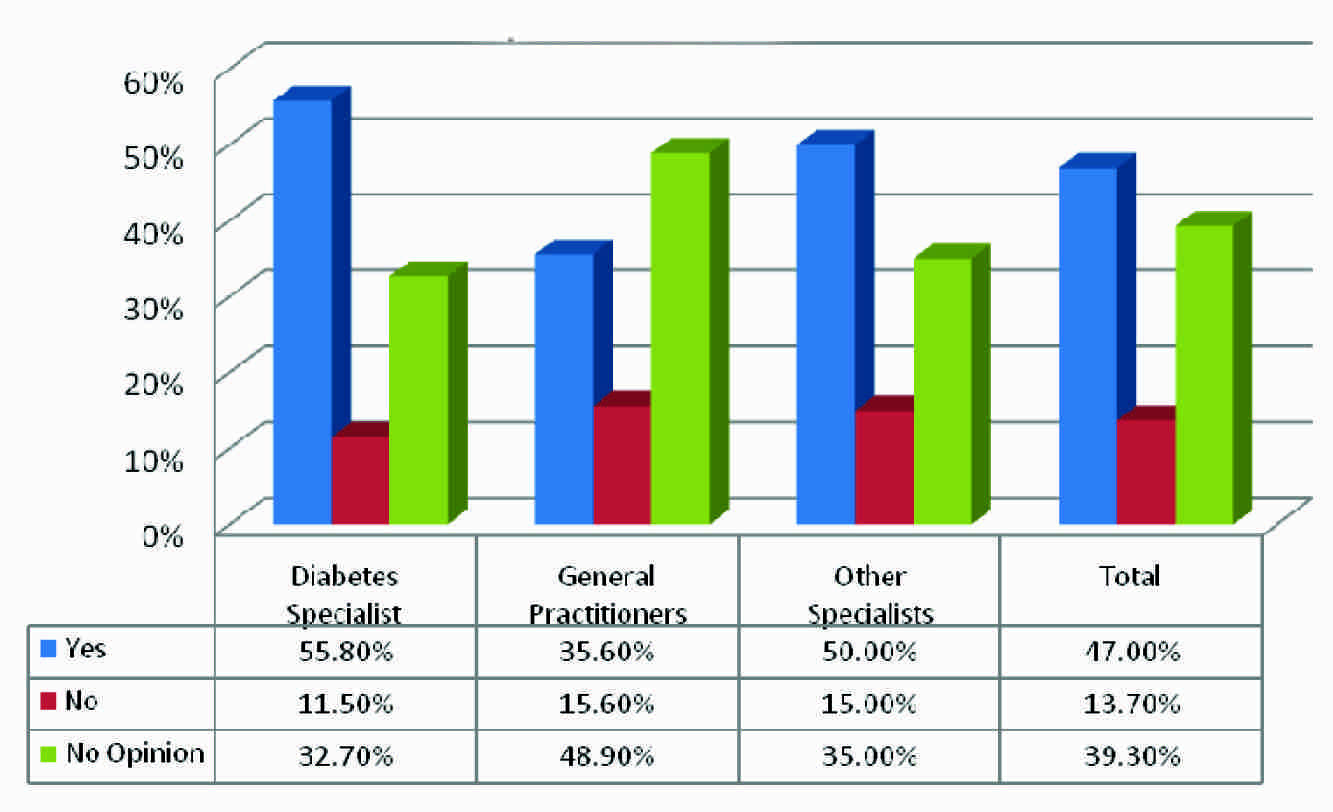
When the respondents were informed that voglibose was approved in Japan for the treatment of prediabetes, most of them agreed that this is relevant in the Indian set up as well [Table/Fig-5].
Vogli is approved in Japan for prevention of onset of type 2 diabetes in patients with impaired glucose tolerance; do you think this holds relevant to Indian patients?
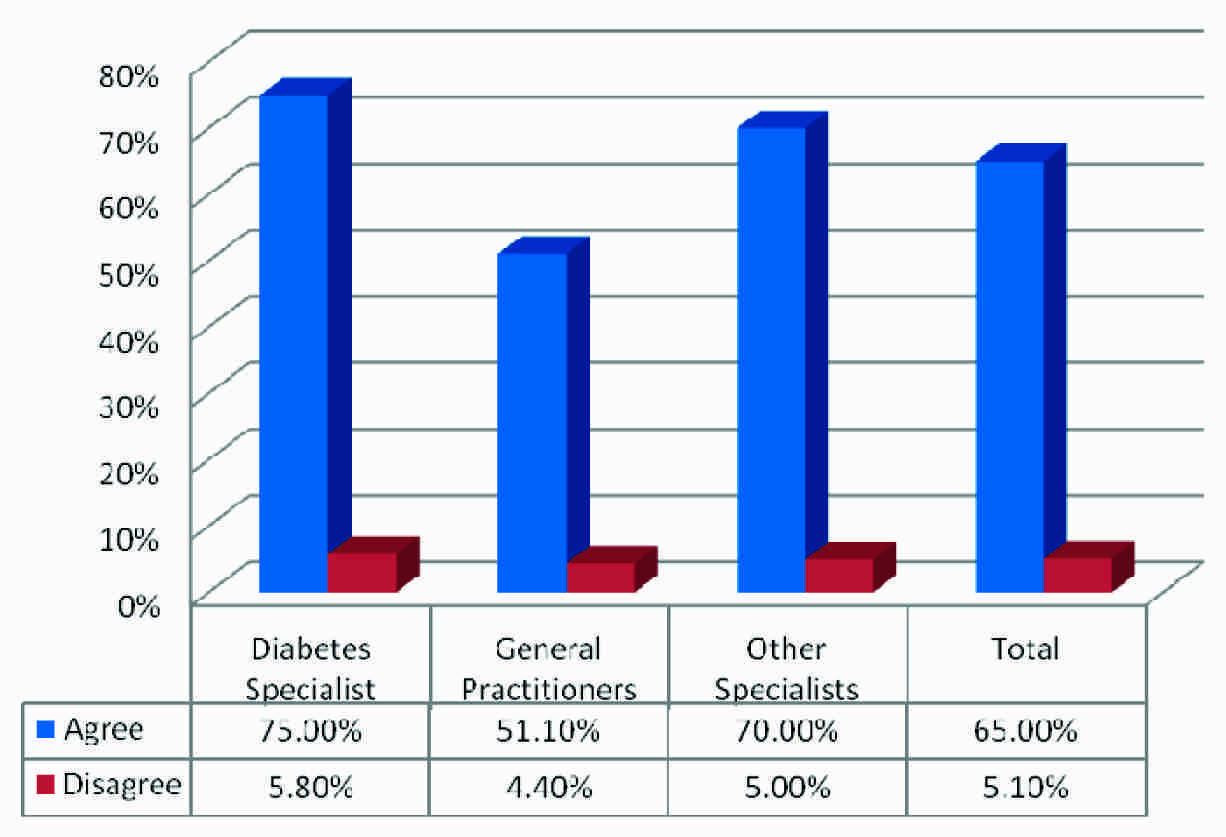
However, only 51.3% of all respondents, and 63.5% of all diabetologists, agreed to have prescribed voglibose for the management of prediabetes [Table/Fig-6].
Have you prescribed voglibose in your patients with prediabetes?
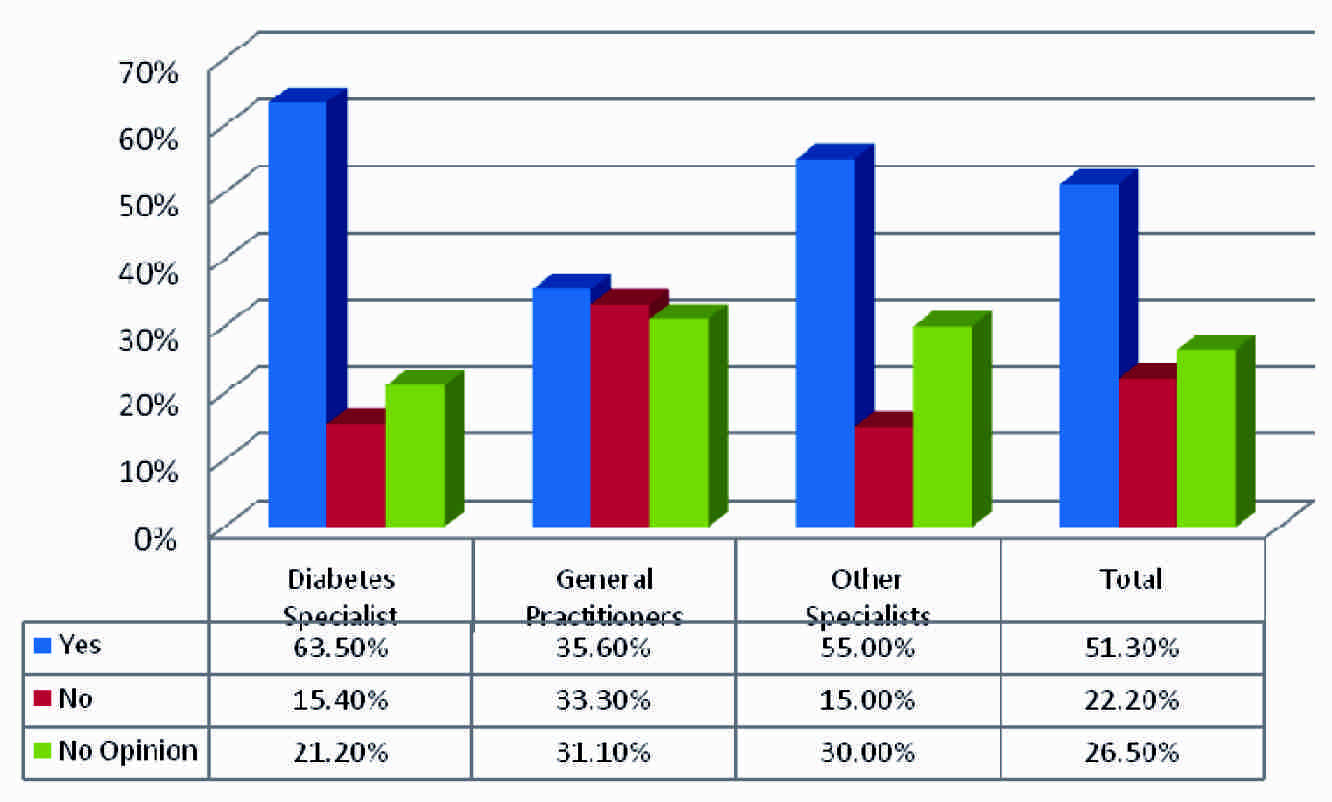
Discussion
Though pre-diabetes is generally regarded as a precursor stage of diabetes, which does not require active management, apart from a strict control in diet and adequate exercise, this view has been challenged ever since voglibose has been approved for the management of prediabetes in Japan [5]. With this in background, this survey was conducted to obtain the views and practices of various types of health care professionals in India.
While the respondents were equivocal with regards to whether or not prediabetes should be managed with diet and exercise only, most of them opined that these patients should be started with an OHA. This reflected the apprehension in the minds of the practitioners in India: though the guidelines say that diet and exercise are enough, most of the practitioners believe that OHAs are also required to halt or delay the progression of prediabetes to overt diabetes.
Metformin, which is the drug which is most often used in the initial therapy of DM, is also the drug which is most often used in the management of prediabetes. This probably results from the fact that metformin reduces blood sugar levels only when its levels are raised and not otherwise.
Alpha glucosidase inhibitors like voglibose was the most favoured second line of management of prediabetes, after metformin. Here, it can be seen that the thiazolidinediones, which include pioglitazone, have been regarded as third line of management, and that the DPP-IV inhibitors were the fourth line of management. This probably is the result of the concern that the therapy of prediabetes with either of these drug classes can lead to hypoglycaemia, which is not a complication which is seen with therapy with either metformin or voglibose.
Finally, most of the respondents agreed to the fact that the approval of voglibose for the management of prediabetes in Japan was very much relevant to Indian patients. Also, 63.5% of all diabetologists and 51.3% of all respondents had prescribed voglibose to their prediabetes patients.
Conclusion
Voglibose is emerging as a popular alternative to metformin for the management of prediabetes in the Indian population. Further, randomized cross trials are required, before the drug can be formally approved for use by the regulatory authorities.
[1]. Barr EL, Zimmet PZ, Welborn TA, Jolley D, Magliano DJ, Dunstan DW, Risk of cardiovascular and all-cause mortality in individuals with diabetes mellitus, impaired fasting glucose, and impaired glucose tolerance: the Australian Diabetes, Obesity, and Lifestyle Study (AusDiab) Circulation 2007 Jul 10 116(2):151-7. [Google Scholar]
[2]. Garber AJ, Handelsman Y, Einhorn D, Bergman DA, Bloomgarden ZT, Fonseca V, Diagnosis and management of prediabetes in the continuum of hyperglycemia: when do the risks of diabetes begin? A consensus statement from the American College of Endocrinology and the American Association of Clinical Endocrinologists Endocr Pract 2008 Oct 14(7):933-46. [Google Scholar]
[3]. Prediabetes. Available online from http://www.diabetes.org/diabetes-basics/prevention/pre-diabetes/ Last accessed on 6th Jan 2013 [Google Scholar]
[4]. Phung OJ, Baker WL, Tongbram V, Bhardwaj A, Coleman CI, Oral antidiabetic drugs and regression from prediabetes to normoglycemia: a meta-analysis Ann Pharmacother 2012 Apr 46(4):469-76. [Google Scholar]
[5]. Basen ®. Available online from http://www.takeda.com/news/2009/20091019_ 3730.html Last accessed on 6th Jan 2013 [Google Scholar]